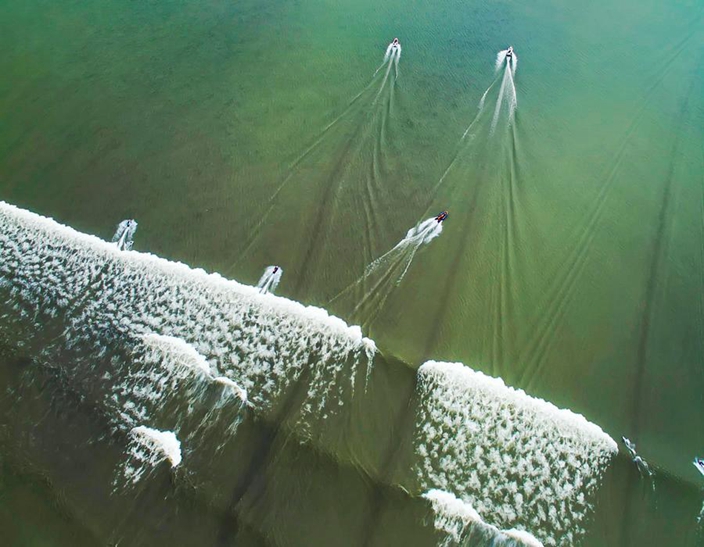..Splendid cross bore seen at #China’s Qiantang River amid Golden Week pic.twitter.com/p2V6AbaTvv— CGTN (@CGTNOfficial) October 7, 2017
Spectacle on the Qiantang River, China
The Qiantang River tidal bore is as famous as the ones on the Ganges in India and the Amazon in Brazil.
The river, originating in the border region of Anhui and Jiangxi provinces, runs for 459 kilometers through the coastal Zhejiang province, passing through the provincial capital Hangzhou before flowing into the East China Sea via the Hangzhou Bay.
The river is the southern terminus of the ancient Grand Canal that links five major rivers in China from north to south, and enables water-borne traffic to travel inland from Hangzhou as far north as Beijing.
While the Hangzhou Bay at the mouth of the Qiantang is about 100 km wide, the river narrows to a mere 2-3 km at one point-its Yanguan section. And as the tidal waters are blocked by the narrow river passage, pressure builds up from behind until a tidal bore is formed, creating a high water wall.

The annual Qiantang River tidal bore, which is expected to be seen this year during the National Day holiday week, attracts tens of thousands of people from home and abroad. (Photo/China Daily)
In addition, the presence of a submerged sandbar at the mouth of the river acts like a springboard for the tide, sending the crest of the bore higher.
Also, combined with the gravitational pull of the celestial bodies and the centrifugal force produced by the rotation of the Earth, tidal waves are created for the first five days and in the middle of every month according to the lunar calendar, which adds up to about 120 days a year.
Around the middle of the eighth month this year, based on the lunar calendar, the tidal force reached its peak, and the waves were as high as 5 meters, with a tidal range of up to 10 meters between the highest and the lowest points.
However, the most extraordinary sight can be expected from Oct 4 to 7 during the country’s yearly National Day holiday week.
The Qiantang tide has been well documented since ancient times.

Thousands of people gather on the bank of the Qiantang River last year to get a view of the annual tidal bore in Hangzhou, Zhejiang province. (Photo/China Daily)
As early as the 4th century BC, China’s famous philosopher Chuang Tzu (Zhuang Zi) described the huge tide as follows: “The waters in the Qiantang River will roll on, raising waves as high as mountains and towers, creating a thunderous roar and gathering up a force that threatens to engulf the sun and the sky.”
A famous poet Su Dongpo in Northern Song Dynasty (960-1127) wrote:
“What on Earth can hope to create a spectacular sight,
Like the tides on the eighteenth of August at night.”
Tide watching on the Qiantang has been a popular activity for centuries, dating back to the Han Dynasty (206BC-AD220).
It had also become a well-established event on the social calendar for both ordinary people and the royal court by the time of the Southern Song Dynasty (1127-1279).

The annual Qiantang River tidal bore, which is expected to be seen this year during the National Day holiday week, attracts tens of thousands of people from home and abroad. (Photo/China Daily)
The Southern Song government even made it a rule to parade its naval forces in the Qiantang River on the 18th day of the eighth lunar month, an event that later developed into the present tide watching festival.
During the festival, expert swimmers line up to test their valor against the might of the tide each year.
There are historical records of men who would attempt to ride the waves of the tide on specially constructed boards.
Known in Chinese as nong chao er or “tide player”, they are regarded as the first generation of Chinese surfers.
It is a tribute to their daring and skill that the words nong chao er have now come to mean people who are brave and courageous in the face of adversity.
In the Song Dynasty (960-1279), the best site to watch the tide bore was the 5-km stretch of riverbank that now lies between Miaozitou and Six Harmonies Pagoda.

The annual Qiantang River tidal bore, which is expected to be seen this year during the National Day holiday week, attracts tens of thousands of people from home and abroad. (Photo/China Daily)
With the passage of time, however, the best spot to get a view of the tidal bore has now shifted to a section of the seawall in Yanguan township in Haining county.
Now, in the small town of Yanguan, about 40 km away from Hangzhou, the Qiantang River Tide Watching Festival is held annually, attracting tens of thousands of people from home and abroad.
Besides the magnificent tidal bore, people can observe other bores-the one-line bore, the cross bore and the back-flow bore.
Yanguan town, where the grand festival is held, offers the best view of the one-line bore. There, the water runs like a line of troops marching forward at a steady pace amid a thunderous sound.
The cross bore is rare and can be seen clearly only from the Jiaxing-Shaoxing bridge in Hangzhou Bay.
There, the Qiantang River tide divides into two strands to pass the sediment accumulation in the bay area.

The annual Qiantang River tidal bore, which is expected to be seen this year during the National Day holiday week, attracts tens of thousands of people from home and abroad. (Photo/China Daily)
The back-flow bore is the most popular one with young people where they wait at the river dike.
When the waters come toward them, the cautious ones move away, but many wait until the 5-meter high water wall crashes into the dike.
The back-flow bore can be experienced at Laoyancang in Haining county, in Jiaxing city, as well as in Qige, in Jianggan district and at the Beauty dike, in Xiaoshan district in Hangzhou.
Be sure to arrive at the place of your choice in time, or you may miss the short but breathtaking spectacle that can be seen only once a year.

The two tides then come closer and flow together like embracing lovers, offering a magnificent view. (Photo/China Daily)

No comments:
Post a Comment